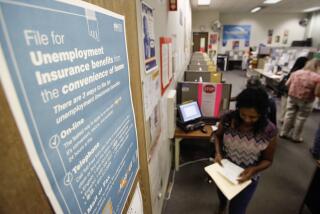The U.S. labor force’s guy problem: Lots of men don’t have a job and aren’t looking for one

The percentage of working-age Americans in the labor force remains stuck near its lowest level since the late 1970s
Reporting from Washington — As the recovery from the Great Recession continues, job growth is solid and the labor force is growing at close to its fastest pace since 2000 because more unemployed workers are coming off the sidelines.
Still, the percentage of working-age Americans in the labor force remains stuck near its lowest level since the late 1970s. Although retiring baby boomers are the main reason, there’s another troubling factor that experts predict won’t be solved by stronger economic growth.
Too many men in their prime don’t have a job and aren’t even looking for one. Experts trying to figure out the reasons are probing the roles of criminal background checks, painkillers and even video games.
In all, about 7 million men ages 25 to 54 are neither employed nor “available for work,” putting them outside the labor force. Their growing numbers worry and puzzle economists.
A little more than half of the men reported they were ill or disabled, according to the Bureau of Labor Statistics. About 14% are going to school. And about 20% said they were either retired or handling home responsibilities.
Economists said increased globalization and the decline in factory jobs has played a major role in pushing prime-aged men, particularly those with less education, out of the workforce. But that doesn’t explain why the problem is worse in the U.S. than in most other economically advanced nations.
Researchers have pointed to some other potential explanations. Prime-age American men outside the labor force are spending more time playing video games, making leisure time more enjoyable. About half are in so much pain from physical maladies that they take daily medication for it, making holding a job difficult.
And in a problem drawing more attention from economists, the nation’s high incarceration rate has left many men with felony convictions that raise red flags during employer background checks.
While the reasons may be up for debate, having so many men failing to contribute has troubling implications for the economy.
“It’s terrible. There’s absolutely nothing good that comes out of it,” said Nicholas Eberstadt, a scholar at the American Enterprise Institute think tank. “It is certainly near the center of so much that is sad and wrong about the way our society and our economy are performing today.”
The problem has been building for a long time.
The percentage of prime-aged men in the U.S. workforce — those either with a job or actively looking for one — peaked at 97.9% in 1954. But since the mid-1960s, the labor force participation rate for those men has steadily declined. The rate has varied during economic booms and busts, but generally has been on a downward trend.
The rate bottomed out at 88% in 2014 and has been hovering near there ever since. The figure was 88.6% in October.
The labor force participation rate for women rose sharply from the mid-1960s through the 1980s as it became more socially acceptable for them to work. But the rate for women has fallen off in recent years, too, to 56.8% in October. The overall participation rate for men and women over 16 years old was 62.8% last month.
The Obama administration was concerned enough about the trend and its implications that the White House Council of Economic Advisors issued a 47-page report this summer examining the reasons for the decline and policies that could help address it. Eberstadt wrote a book on the subject, “Men Without Work, America’s Invisible Crisis,” that was published in September. And economists have been studying the phenomenon.
Alan Krueger, a Princeton economist, published a paper last month titled “Where Have All the Workers Gone?” that said “addressing the decades-long slide in labor force participation by prime age men should be a national priority.”
“We’re not fully utilizing the human resources we have and that means the economy is not performing as well as it could be,” Krueger said in an interview. “That means our overall standard of living is lower because output is lower than it can be.”
Krueger, who chaired the White House Council of Economic Advisors from 2011 to 2013, added to the debate over the issue by conducting a survey that found that 47% of prime-aged men who are out of the workforce said they took pain medication the previous day. Nearly two-thirds of those reported that they took prescription painkillers.
When asked if pain prevented them from working at a full-time job, 40% of prime-aged men out of the workforce said yes, Krueger found.
He said he hasn’t been able to determine if the pain problems are a cause or an effect for the men being out of the workforce.
“I suspect the arrows go in both directions,” Krueger said. “Some had severe disabilities that caused them to withdraw [from the workforce] and others became despondent and perhaps obese from their lifestyles which caused disability problems.”
Research this year by Krueger’s Princeton colleague, economist Mark Aguiar, pointed to another potential reason — the lure of video games.
Video games have become more elaborate and sophisticated, while online gaming has expanded the universe of people to play against.
The life of these nonworking, lower-skilled young men looks like what my son wishes his life was like now: not in school, not at work, and lots of video games.
— Erik Hurst, University of Chicago economist
Men ages 21-30 who were not in the workforce reported spending an average of 6.7 hours a week playing video games from 2012 to 2015, compared with just 3.6 hours from 2000 to 2007.
The figures are higher for men in that age group with less than a college education. Erik Hurst, an economist at the University of Chicago’s Booth School of Business, found that those men spent an average of two hours a day on video games in 2014, with 10% of them reporting playing for six hours a day.
About seven in 10 lower-skilled men in their 20s without a job lived with a parent or close relative, according to his research. But despite that, they reported being happier on average than they were in the early 2000s.
“The life of these nonworking, lower-skilled young men looks like what my son wishes his life was like now: not in school, not at work, and lots of video games,” Hurst wrote recently.
Eberstadt said the “most scandalously ignored” reason why so many prime-aged men are not in the workforce is the nation’s high incarceration rate. As many as 20 million Americans, most of them men, have a felony record. That could help explain why the labor force problem is worse here than in other advanced economies, he said.
The U.S. has the world’s second-highest prison population rate — 698 prisoners for every 100,000 people, according to the Institute for Criminal Policy Research. People in prison are not counted in any way in U.S. labor statistics, which look only at the civilian non-institutionalized population.
“Is there discrimination against felons and ex-cons? Do they lose their skills in jail?” Eberstadt said. “This is a huge missing piece of the puzzle.”
Joel Valdez, 32, of Los Angeles, was paroled in June from California’s Chuckawalla Valley State Prison after more than 15 years behind bars for his conviction on two counts of assault with a firearm. He’s been working at a voter-engagement phone bank that employs mostly former inmates and is operated by LA Voice, a faith-based community organization. But it’s been difficult to find work with a felony record and, even though he earned a high-school equivalency degree in prison, he didn’t get much training.
“I know that, more often than not, if I’m not working in a warehouse or getting my foot in the door through labor jobs or having family friends, that it would be super hard to get a job because of my background,” Valdez said. “Some people are sketchy about hiring people with that background. It’s tough.”
A Los Angeles City Council committee approved an ordinance in September that would prevent most employers from asking about a job applicant’s criminal history until after a conditional offer has been made.
Reforming the criminal justice system, including “improving reentry into the workforce for the formerly incarcerated,” is among the ways to get more prime-aged men back into the workforce, according to the White House report.
Its other recommendations included changing the tax code to expand work incentives and creating more demand for workers through funding for infrastructure upgrades.
Eberstadt said that overhauling disability programs also could help push more prime-aged men back into the workforce by removing a key source of income. Expanding health insurance coverage also could address the problem of out-of-work men taking painkillers.
“If men have preventative care and treat problems earlier on it could prevent them from causing the kinds of chronic pain that seems to be a barrier to work for so many people,” Krueger said.
To read the article in Spanish, click here
Follow @JimPuzzanghera on Twitter
MORE BUSINESS NEWS
Breitbart News, fiery conservative outlet buoyed by Trump victory, aims to go global
How to protect an elderly widower from financial predators
Facebook’s Zuckerberg offers plan to counter fake news sites
UPDATES:
11:50 a.m.: This article was updated to note that Erik Hurst is an economist at the Booth School of Business at the University of Chicago.
This article originally was published at 5 a.m.











